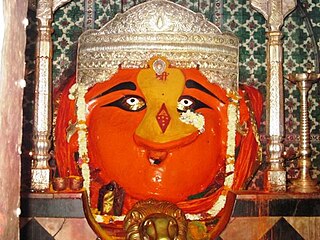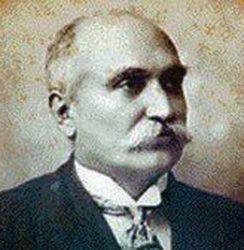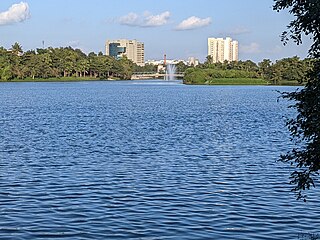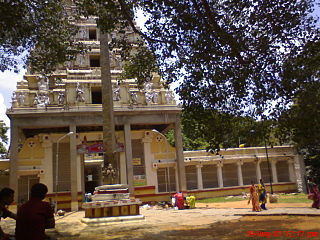
Kolar district is a district in the state of Karnataka, India.

Devanahalli, also called "Devandahalli", "Dyaavandalli", Devanadoddi, and Devanapura, is a town and Town Municipal Council in Bengaluru Rural district in the state of Karnataka in India. The town is located 40 kilometres (25 mi) to the north-east of Bengaluru. Devanahalli is the site of Kempegowda International Airport. A multibillion-dollar Devanahalli Business Park with two IT Parks are coming up on nearly 400 acres (1.6 km2) adjoining the airport. An Aerospace Park, Science Park and a ₹10 billion (US$120 million) Financial City are also coming up. A new satellite ring road will connect the city with Doddaballapur. Devanahalli is situated near the upcoming ₹1,500 billion (US$18 billion), 12,000-acre (49 km2) BIAL IT Investment Region, to be the largest IT region in India.

Renuka, also known as Yellamma, is a Hindu mother Goddess worshipped predominantly in the South Indian states of Karnataka, Tamil Nadu, Telangana, Andhra Pradesh and the western state of Maharashtra. She is the mother of Parashurama, the sixth avatar of god Vishnu. She was given the name "Renuka" and acquired the status of a mother goddess before eventually being associated with the legend of Parashurama.

Basavanagudi is a residential and commercial locality in the Indian city of Bangalore. Basavanagudi is one of the oldest localities of Bangalore evidenced by the fact that it is home to four inscriptions, three Kannada and one Tamil and also one of the poshest areas of Bangalore. It is located in South Bangalore, along the borders of Jayanagar and Lalbagh Botanical Gardens. The name "Basavanagudi" refers to the Bull Temple, which contains a monolithic statue of the Nandi Bull. The word Basava in Kannada means bull, and gudi means temple. The main commercial street in Basavanagudi is DVG Road, which is home to numerous retail businesses - several of them dating back to the 1920s and 1930s. Towards the middle of DVG Road is Gandhi Bazaar, known for its market which sells fresh flowers, fruits, and vegetables. The neighbourhood includes several historic restaurants, notably Vidyarthi Bhavan, a vegetarian restaurant which opened in 1943.

Magadi is a town and taluk located in Bengaluru South district, Karnataka, India.

Malleshwaram is a northwest neighborhood and one of the zones of Bruhat Bengaluru Mahanagara Palike in Bengaluru, India. It was planned in 1889 after the great plague of 1898, developed as a suburb in 1892 and handed over to the city municipality in 1895. As per the 1878 Survey of India map, the area came under the village of Ranganatha Palya and was later named after the Kadu Malleshwara Temple. The neighbourhood houses many offices, one them being World Trade Center Bengaluru. It has two shopping malls, Mantri Square and Orion Mall. As an education hub,it houses the education boards of the state KSEEB and PU boards,Mysore Education Society and Indian Institute of Science.
Ereyanga was the son of Vinayaditya and distinguished himself as a Chalukya feudatory during their campaigns against Dhara of Malwa. Though he remained the Yuvaraja or crown prince for several decades, his rule as a monarch of Hoysala Empire was short. He was a Jain by faith and took the title 'Vira Ganga'.
Epigraphia Carnatica is a set of books on epigraphy of the Old Mysore region of India, compiled by Benjamin Lewis Rice, the Director of the Mysore Archaeological Department. Over a period of about ten years between 1894 and 1905, Rice published the books in a set of twelve volumes. The books contain the study of about 9,000 inscriptions from lithic surfaces and copper plates, which were found in the region. Apart from the original inscription, an English translation and a Roman transliteration are also provided.

Benjamin Lewis Rice, popularly known as B. L. Rice, was a British historian, archaeologist and educationist. He is known for his pioneering work in deciphering inscriptions, especially in Kannada, and in Sanskrit inscriptions in the Kingdom of Mysore and is eulogized as Shasanapitamaha or Purathathva Pitamaha Rice's researches were published as the voluminous Epigraphia Carnatica which contains translations of about 9000 inscriptions he found in the Old Mysore area. Rice also compiled the much acclaimed Mysore Gazetteer which still remains the primary source of information for most places in Mysore and neighbouring Coorg. Rice served with distinction in the Mysore civil service and as first Director of the Mysore State Archaeology Department.
Neraluru is a village in Anekal taluk, Bangalore urban district, India. It is around 28 kilometers from Bangalore and 10 kilometers from Hosur, Tamil Nadu. The nearest mofussil towns are Attibele and Chandapura, both of which are within a 5 kilometer radius of Neralur. Electronics City, one of India's largest Information Technology parks, is around 10 kilometres from the village. A few of the villages which share its boundaries with Neralur are - Guddahatti, Balagaranahalli, Lakshmisagara, Old Chandapura, Thirumagondanahalli, Bandapura, Yadavanahalli and Bendaganahalli. Kannada is the most widely spoken language in the village.

Shri Dharmaraya Swamy Temple is one of the oldest and most famous Hindu temples of the city of Bangalore, in Karnataka, India.
Chokkanathaswamy temple, at Domlur in the Indian city of Bangalore, Karnataka, India, is dedicated to the deity known as Chokkanathaswamy or Chokka Perumal. It is one of the oldest temples in the city. The temple has numerous Kannada and Tamil inscriptions that have been documented in the Epigraphia Carnatica Vol 9, Bangalore District (1905ed). Based on these inscriptions the temple is at least as old as 1200 CE.

The Ranganatha Swamy Temple at Nirthadi, is a post-Vijayanagara Empire re-construction. Nirthadi is a village in the Davangere district of Karnataka state, India. According to noted historian and epigraphist Benjamin Lewis Rice, a Kannada language inscription dated 1698 AD in the temple premise describes the destruction of the original temple by the armies of Mogul emperor Aurangzeb in 1696 AD. The Chitradurga chief Baramappa Nayaka (r.1689–1721) rebuilt the temple in 1698 AD. The monument is protected by the Karnataka state division of Archaeological Survey of India.
There are nearly a thousand inscriptions in Tamil in the Southern Karnataka districts of Bangalore, Mysore, Kolar and Mandya in India. Nearly one third of these inscriptions are found in the Kolar District. Of all the inscriptions collected and published in the Epigraphia Carnatica Vol X for Kolar district, a fourth are in Tamil. The Tamil inscriptions start to appear around 1000 AD, after the conquest of the region by the Chola dynasty king Rajaraja I. Even after the Cholas left the area, the Hoysala and later the Vijaynagar kingdoms continued to use Tamil in the inscriptions.

Mysore Hatti Krishna Iyengar was an Indian historian, archaeologist, epigraphist and authority in Indian numismatics. He pioneered the new field of Indology involving the study of Indian culture, history, music and traditions from a historical perspective. He is credited with the discovery of one of the oldest Kannada inscriptions, the Halmidi inscription, dating back to 350 A. D. He also discovered the remains of the city of Isila near Brahmagiri during his excavations at Chandravalli, Chitradurga. The forgotten tomb of Shahaji was traced by M. H. Krishna during his years at the Mysore Archaeological Department. His years at the Archaeology Department saw him churn out many of excavation reports and these were later published in successive volumes of Epigraphia Carnatica. During Krishna's tenure at Bangalore, he was instrumental in cataloguing close to 6000 coins in the archives of the archaeology department there. He was trained at the University College, London under Ernest Arthur Gardner. and would later accompany Sir Flinders Petrie in his excavations in Egypt.

Malleshwaram is a North-Western locality of Bengaluru and one of the oldest planned layouts of Bengaluru. In 1898 when Bangalore was hit by the plague epidemic, Malleshwaram was developed on modern lines as a new residential locality of the city. However, as evidenced by Ekoji's inscription the village of Mallapura had existed since at least 1669CE. The name Mallapura is derived from two words, Malai meaning "hill" and Pura meaning "town". The name Mallapura has since changed to Malleshwara over the years.

Domlur is a locality in the eastern part of Bengaluru city in India. Domlur is a historic places as indicated in the 18 inscriptions spanning the period 1200-1440CE found there. Of these, 16 inscriptions are at the Chokkanathaswamy Temple dedicated to the deity Chokkanathaswamy or the Chokka Perumal [the Hindu God Vishnu]. Of these eleven inscriptions are from the period 1200-1440 CE and have been documented earlier in Epigraphia Carnatica, Vol 9, these are mostly donatory inscriptions for the deity Chokkanathaswamy and for the Someshwara temple (non-existent).

Singapura is a locality in the northwestern part of Bengaluru, Karnataka, India. The Varadarajaswamy Temple in Singapura is at least 500 years old, as recorded in Harohalli and Chikkabettahalli inscriptions. The temple is referred to as the Tiruvengalanatha temple in inscriptions. The inscriptions also mention a grant given to Ramanuja Koota, a religious institution of Sri Vaishnavites, named after the reformer-saint Ramanuja.

Allalasandra is a historic locality in North Bengaluru adjoining the Gandhi Krishi Vigyan Kendra (GKVK) campus on Bellary road. Allasandra's historicity tracing back to about 500 years can be attested from the Rachur Narasappiah's Donation Inscription mentions the donation of the entire village of Allalasandra to the Allalanatha temple at Jakkur.

The Basavanagudi Inscriptions are a set of three Kannada and one Tamil inscriptions that can be found in the locality of Basavanagudi. Of the four, three Kannada inscriptions are physically present and the fourth Tamil inscription's physical status remains unknown. The available Kannada inscriptions can be found in Bugle rock park and Dodda Basavana Gudi or Big bull temple. Two inscriptions found in the vicinity of Dodda Basavana Gudi or Big bull temple, both describe the Vrishabhavati river's origin as coming from the feet of the Basava idol in the temple's sanctum and flowing westwards thereon as Paschimavahini. The two inscriptions can be found: one on the pedestal of the Basava deity in the sanctum and the other on a boulder in the shrubbery surrounding the temple. Two more inscriptions that are published, one is a one line Tamil inscription in Grantha script published in Epigraphia Carnatica and is about possible donatory inscription to the Chokkanathaswamy Temple in Domlur, a locality in Bengaluru, its physical status is not known at present and the other is a one line Kannada inscription in the Kannada script published in Itihasa Darshana Journal and is present on a boulder in the Bugle rock park in Basavanagudi is about one Deevatige Soma.














